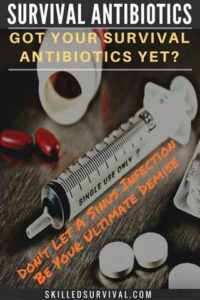
A Complete Guide To Finding & Acquiring Prepper Antibiotics Today
- You have a cache of weapons & ammo
- Your bug-out bag is ready to go
- You have food & water
But will your demise be a sinus infection?
Antibiotics should be a part of everyone’s prepper medical supply.
Note: The ultimate solution to survival antibiotics is Jase Medical.
It’s a company that helps you get the antibiotics and meds you need BEFORE a crisis hits…
TOPICS IN THIS GUIDE… ↓(click to jump)
- It Was Only A Scratch…
- How Antibiotics Changed Life
- Which Infections Are Worst?
- A Quick Antibiotics Lesson…
- Solution To The Access Problem
- Antibiotic Resistance Problem
- Use Only In A REAL Emergency…
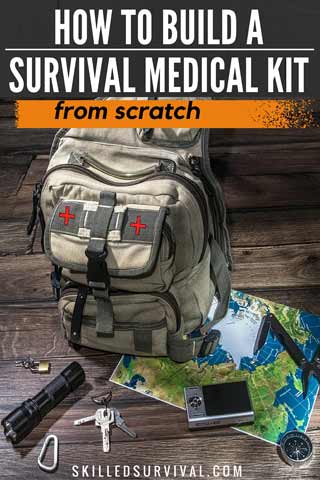
Want a free survival medical kit checklist?
Click here to instantly download this Complete Checklist PDF. No purchase necessary.It Was Only A Scratch, But That’s All It Takes
For me, it wasn’t OK when I was on the verge of a week-long Army field training exercise.
After a few days of military-style sleep deprivation and poor hygiene, a little scratch on my knuckle had become a swollen mess of pus.
Don’t judge.
I figured out I could get an extra 15 minutes of sleep if I showered only every other day.
It was a time that I measured sleep in minutes rather than hours, and this seemed like a solid plan.
As we prepared our gear for inspection, I noticed a red line snaking from the pink scratch up to my forearm that appeared to follow a vein.
A couple of hours later, the angry red line reached my armpit.
Also, by then, I felt like I had a hangover from hell, even though I hadn’t had a drink in over a week.
I was concerned enough at this point to show my squad leader.
After berating me for being too stupid to care for a mere scratch and too weak to heal myself, he sent me to a sick call.
I received Motrin, a painful shot of antibiotics in the butt, and seven days’ worth of pills.
Within hours, I limped through a road march, embracing the suck for my FTX. Hooah.
I can only imagine what would have happened without those antibiotics.
- Septicemia.
- Blood poisoning.
- Death.
Most likely, I would be dead now if not for antibiotics.
From a scratch on my knuckle!
Antibiotics Changed Life As We Know It
Antibiotics changed medicine and life as we know it.
Before Alexander Fleming’s 1928 discovery of penicillin, there were a few options for treating bacterial infections.
1. Removal.
You could cut off the limb or cut out that infected pound of flesh.
Surgery is probably a bad plan in an SHTF world without that sterile O.R., not to mention the actual surgeon.
2. Natural remedies.
You could cover it with a natural poultice or use other various natural resources.
Natural remedies is an article in itself, possibly a book.
So here is a link to some simple antibacterial poultices.
3. The immune system.
You could wait and see if your immune system destroys the offending germ.
The body does a pretty good job of defeating a lot of bugs.
That said, the body depends on everything being in good working order.
A healthy immune system is well-fed, well-rested, and focused only on the task at hand:
Kill that disease! So lots of bed rest.
No foraging or fighting off pillagers. Just heal.
Diarrhea, a snotty nose, fever, vomiting.
These are all part of the body’s attempt to eliminate the germ.
Cook the germ. Flush it out.
Each of those things taxes your body and uses more of those valuable resources: Food, water, and energy.
That’s the guy in the zombie movie that everyone talks about leaving behind because “he’s slowing us down, and he probably won’t make it anyhow.”
The development of antibiotics for medical use began in the 1940s, and many illnesses moved from having a prognosis of certain death to a prognosis of 10 days of pill-popping as life went on.
Before the 1940s, my ominous red line? Not good.
So Which Infections Are Most Concerning?
Even today, the death rate for septicemia is around 50%.
Bacterial skin infections (mostly staph infections) had a mortality rate of 11%.
After the introduction of antibiotics, the death rate fell by 100-fold.
I’m no statistician, but that seems like a win.
How about Meningitis without antibiotics?
Write your epitaph quickly before your mind gets cooked.
Please note that many changes in life and medicine occurred at about the same time as the discovery of antibiotics that helped boost survival rates.
To say that any bacterial infection untreated by antibiotics is a death sentence would be an exaggeration.
It would be more realistic to call survival antibiotics one crucial tool in the bag that will help you stay alive.
Other changes that seem so common sense to us now were becoming the norm in the early 20th century.
- Cleanliness (handwashing, room cleaning, proper garbage disposal, sewage treatment, clean water).
- Vaccinations.
- Improved food supply.
- Improvements in shelter design.
Overall Achievements In Public Health.
- Now, what do you think will disappear in our SHTF scenario?
- Will the garbage man still do his rounds?
- Can you take daily hot showers when life-giving water is scarce?
- Will your home still be a comfy 68 degrees when the grid goes down?
- Can you still get your five servings of vegetables a day?
You get the point…things will be much different.
An SHTF world is a pre-antibiotic world.
All of the things that helped improve the average lifespan from the mid-forties in the early 20th century to nearly eighty in the early 21st century, sanitation, a steady food supply, and a good night’s sleep, they’ll be a thing of the past.
However, one big difference is that antibiotics will still exist.
The question is:
Will YOU have access to them?
The answer will be the same as any other prepper question.
If you think ahead and prepare for the problem before you have the problem, you’ll be okay.
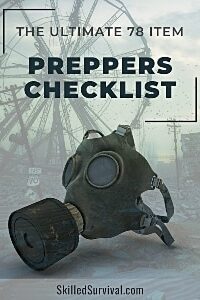
Want a free 78 item prepper checklist?
Click here to instantly download this Complete Checklist PDF. No purchase necessary.But First, A Quick Antibiotic Lesson
There are two basic types of antibiotics: Broad-spectrum antibiotics and Narrow spectrum antibiotics.
Think of it as a frag grenade versus a well-placed sniper shot.
Broad-spectrum antibiotics kill most types of bacteria.
Doctors use these antibiotics when they can’t name that dog.
If they don’t know what kind of bacteria they need to kill, broad-spectrum antibiotics kill ‘em all and let God sort ‘em out.
Broad-spectrum antibiotics are a good plan for those who come into the ER so sick that antibiotics must be getting to work within minutes and hours.
It’s also a good plan for a layperson who knows that he or she has a bad bacteria but has no clue which bug is trying to kill him or her.
The drawback with these is that your body plays the part of God and has to sort ‘em out.
Your body has to deal with a system that doesn’t have good, bad, or ugly bacteria in or on it anymore.
Good bacteria do the following:
- It helps the skin stay healthy and keeps the bad stuff out.
- Live in your gut and break down food to absorb those nutrients.
- Act as an antibiotic of sorts by competing with and crowding out harmful bacteria.
The body has a lot of bacteria that are necessary for you to survive.
Broad-spectrum antibiotics kill the good guys and the bad guys.
What can result from wiping out all your bacteria?
- Vaginal yeast infections. Good luck getting cranberry juice and yogurt in the SHTF world.
- Thrush. That’s a yeast infection in your mouth. Yuck.
- Clostridium difficile “C-diff” is an opportunist bacteria that grows when the good stuff disappears and causes terrible diarrhea. It kills 29,000 people every year.
All that besides the normal side effects that antibiotics have, like diarrhea (which actually evens out the constipation of a straight MRE diet), rash, and nausea.
Narrow-spectrum antibiotics kill certain bacteria.
In cases where the doctor is confident which bacteria needs treatment, these are the smart choice.
Narrow-spectrum antibiotics will spare your good bacteria and keep you in the fight.
I don’t recommend stocking up on these because you’re not very likely to be able to identify your killer germ without some pretty good medical knowledge or a still-working WebMD.
There are exceptions.
You can research which of these medications might be worth trying for which bacterial infections.
Azithromycin, for example, is a go-to for sinus infections.
Did you know that some of your sinuses are separated from your brain by mere millimeters of bone tissue?
You should now be asking: How do I get antibiotics?
You know…legally, without lying to my doctor.
Answer To The Antibiotics Problem
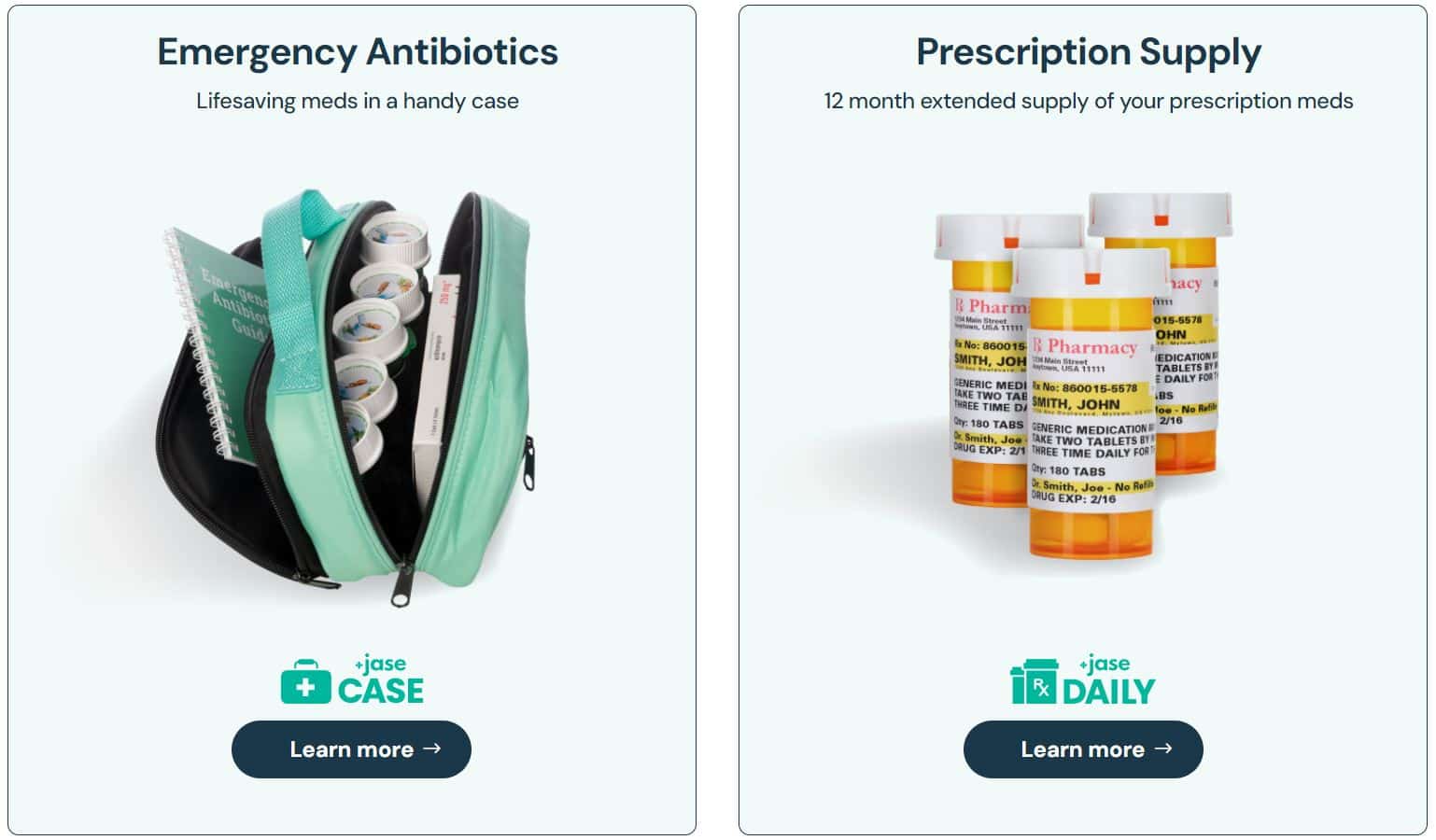
Jase Medical handles everything to get a stockpile of survival antibiotics into your hands.
From online evaluation to using a licensed pharmacy medication delivery system and even ongoing consultation.
You can trust them because they’re endorsed by Glenn Beck, Ben Shapiro and Steve Bannon (see their quotes on their site).
OR you can take your chances with Fish Antibiotics…
Fish Antibiotics
The easy answer is fish antibiotics.
If you don’t want to bank on the lifesaving capabilities of a lump of clay, a good fever, and some hope, stock up on fish antibiotics.
You don’t need a prescription or even pocket medically prescribed antibiotics that were given to you for a real illness.
- You need to look online and make an order.
- Or go to your local pet store.
Fish antibiotics aren’t controlled substances, so you shouldn’t be given the third degree for buying antibiotics from the pet store clerks.
Just tell them that you need fish antibiotics, fish mox, fish-cillin, or fish-cin, or whichever survival antibiotic you decide is right for you and your family.
↓ My Top Antibiotics to Store for Preparedness, by Dr. Joseph Alton
However, bird antibiotics are a good option, too.
Click here to see how many antibiotics are readily available online.
I suggest you do some research yourself; this article is NOT medical advice; always discuss your health situation with a medical professional.
Know your allergies and the allergies of the people that you’ll be in charge of keeping alive.
For example:
If you have a penicillin allergy in the house, stay away from anything that ends with cillin.
Know the doses that you’ll need for various illnesses and keep the list with the prepper antibiotics in a cool, dry place.
Also, doses of medications vary by person and by disease treated.
For example:
Amoxicillin for a throat infection might be 250mg thrice daily for seven days.
For a dental abscess, 500mg thrice daily for five days.
However, if you have kids, know that the doses will change as they grow.
I have fish flex and fish myosin.
My wife is allergic to sulfa, so BIRD SULFA is not an option for her.
↓ Top 5 Antibiotics to Stockpile for Emergencies
Note: Most sites discuss in legal jargon that these products are not for human consumption and, at the same time, tell you that they are the exact same drug that your doctor prescribes with the same stringent FDA regulations.
WARNING! Antibiotic Resistance Is a Huge Problem
Superbugs are on the prowl and could lead us to an SHTF world.
Antibiotic resistance is a huge problem and is more likely to destroy life as we know it than nuclear annihilation.
In fact, when you search for antibiotics online, much of what you’ll find will be articles about the danger we face as a society because of our overuse of antibiotics.
The main reason for this is the inappropriate use of antibiotics.
Doctors prescribe them for viruses because patients don’t want to hear, “It’s a virus. Drink fluids and rest.”
Patients take seven days of antibiotics instead of the ten prescribed days because they feel better.
What happens, then?
All that’s left at the end of seven days are the bacteria that could resist the seven-day onslaught.
The tough ones. The superbugs.
Plus, those germs recover and reproduce.
Now we have MRSA and VRSA. Acronyms for bacteria are so tough to kill that killing them may kill you in the process.
↓ When Antibiotics Don’t Work (full documentary) | FRONTLINE
The bottom line:
Do not use your prepper antibiotics to turn yourself into your own doctor!
Recognizing that a red line going up your arm as a bacterial infection does not put the M.D. behind your name.
Go to the doctor!

Want a free 78 item prepper checklist?
Click here to instantly download this Complete Checklist PDF. No purchase necessary.Your problem may require more attention than a dozen FISH-MOX antibiotics.
Do some additional research.
Know your medications and their limitations.
For example, for most medications, you can double the expiration date.
If it expires in two years, it’s probably good for four. But know before you take liberties.
Tetracycline, for example, becomes toxic to your kidneys after expiration.
Before the SHTF, while we still live in a world where people are going to school for eight years to learn this stuff, you should not play doctor with your or your family’s health just because you read an article on the internet.
If you take antibiotics wrong, you might be the one that creates the Superbug.
Don’t be Patient Zero.
Don’t Be The One That Makes The Shit Hit The Fan.
However, when doctors and medical supplies are rare (or non-existent) after SHTF, you better have a stash of survival antibiotics lying around for that sinus infection…just in case.
Plus, antibiotics will make an excellent survival bartering item.
Just imagine how much your neighbor with a severe infection will trade you for a few fish antibiotics.
The prudent see danger and take refuge, but the simple keep going and pay the penalty. Proverbs 22:3
Cody Mo
P.s. Do You Live In A 'Danger Zone' County?
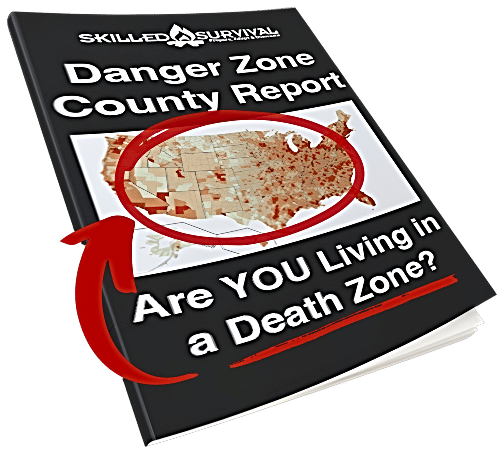
Find out now using my Danger Zone County List & Special Report it’s absolutely FREE.
In minutes you’ll know EXACTLY where you stand and if you should be worried or not..
So click here to get my FREE Danger Zone County List & Report…
Photo Credit: Top / Scratch / Fish

Recommended Reading
Best Fuel Storage Ideas: How To Store Extra Gasoline
Long term fuel storage is crucial in all survival situations, but fuels must be stored properly and safely to keep, especially long term gasoline storage.
How To Store Seeds For Wise Prepping & Survival
When seed saving and seed storage, you must do it right. Learn how to store seeds so they'll thrive the next planting season.
Common Everyday Carry Mistakes YOU Must Avoid At All Costs
The only person qualified to build YOUR Best Everyday Carry (EDC) is YOU. To do it right, you must avoid these common mistakes and pitfalls.
Strategic Relocation: How To Find A Safe Pace To Live
Use strategic relocation to find a safe, defendable location to call home. Your choice of location WILL determine your survival fate.
Map Of Nuclear Fallout: Would I Survive A Nuclear Bomb?
Have you seen a map of nuclear fallout? Or run a nuclear simulation to see the damage a nuke would do to your city? If not, check this out.
Homestead Survival: How To Master Plan Your Own Safe Haven
Use this simple 6 step action plan to successfully plan and build a homestead to survive (and thrive) even if the world falls into chaos...


